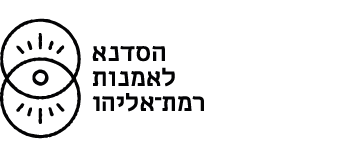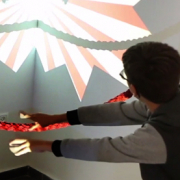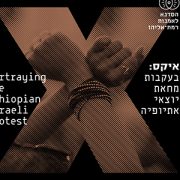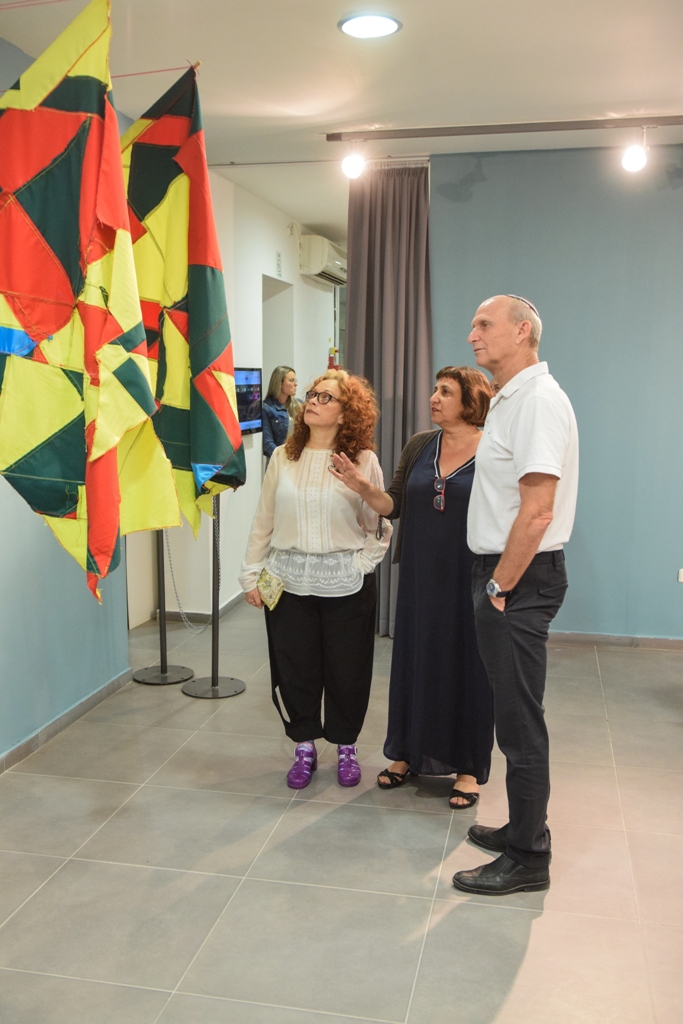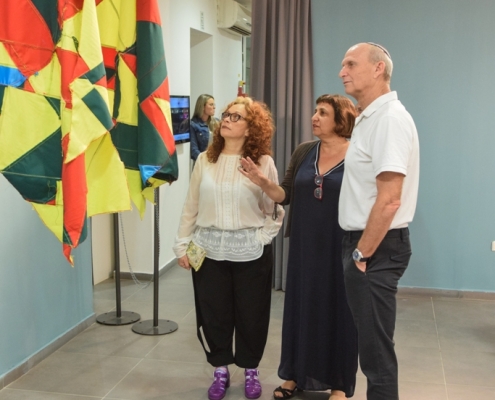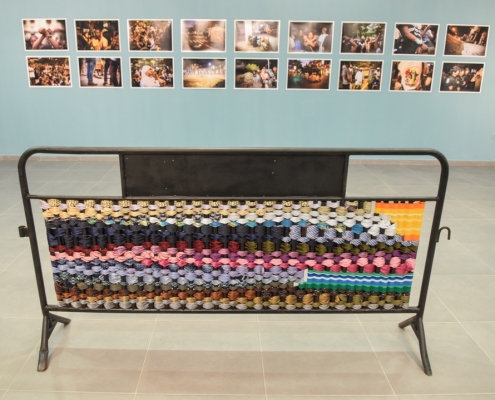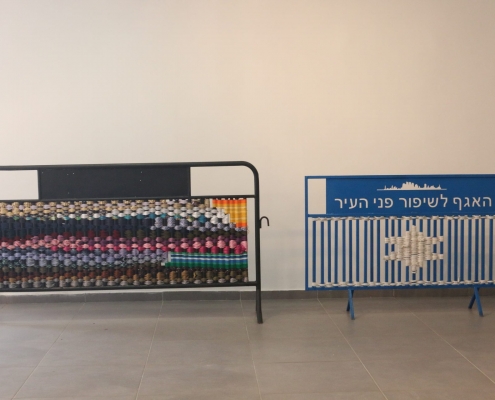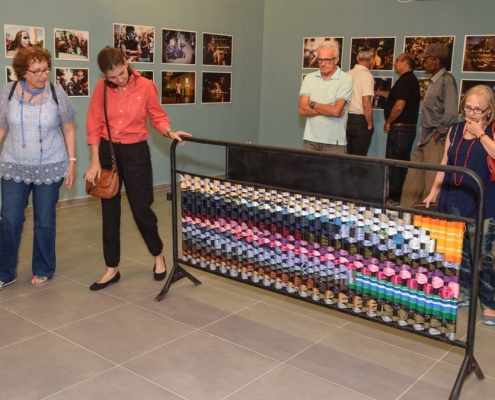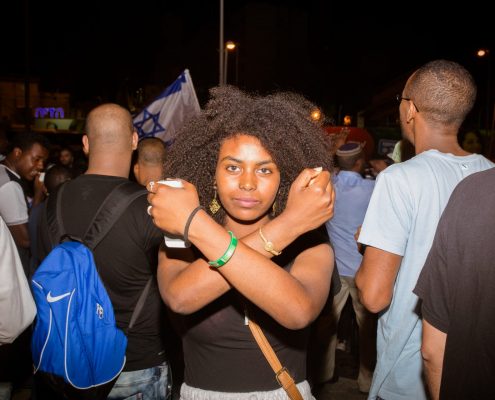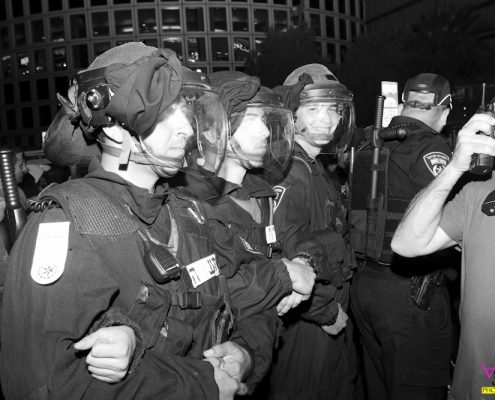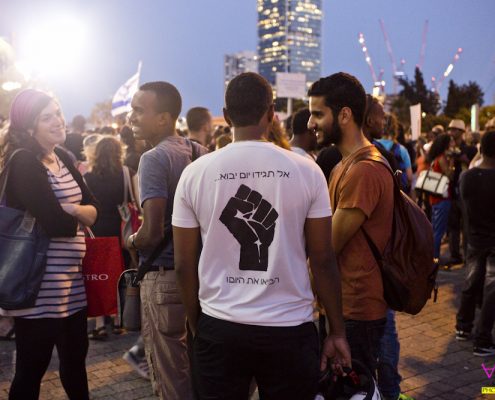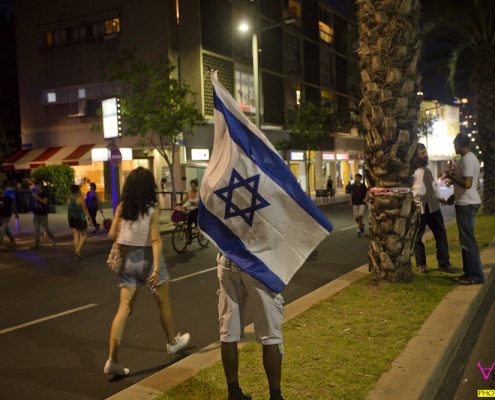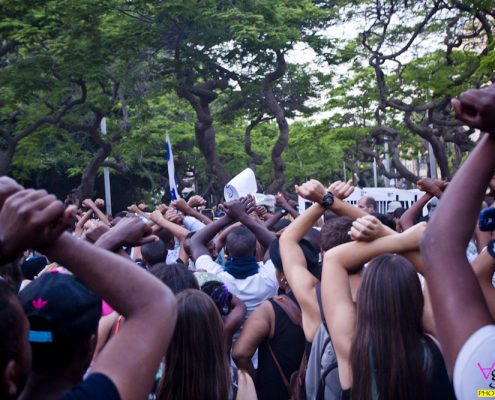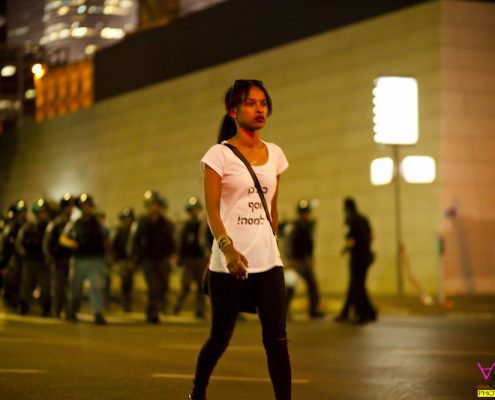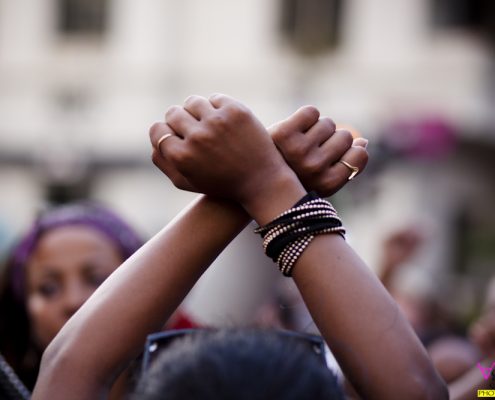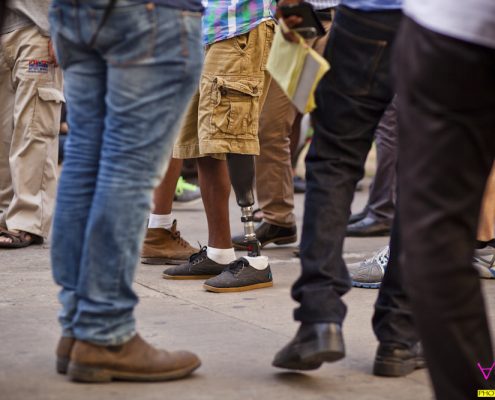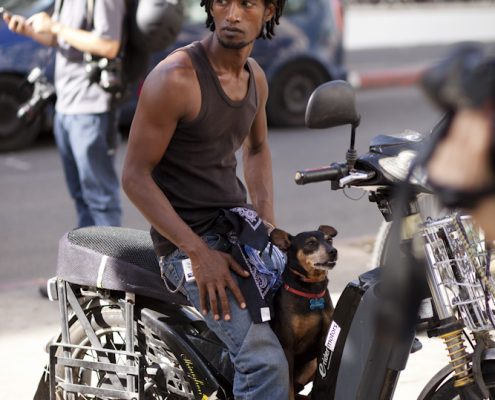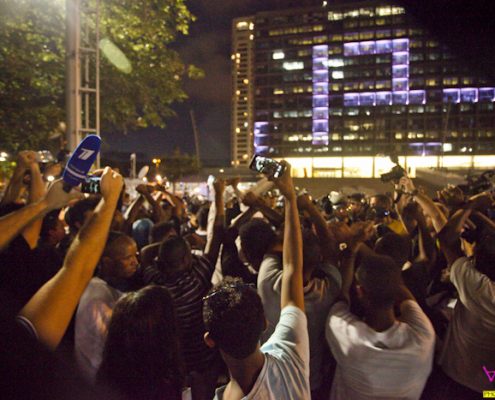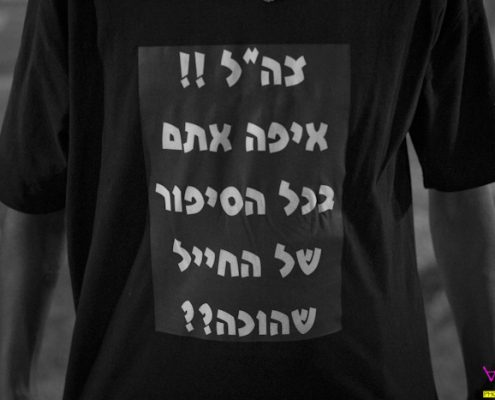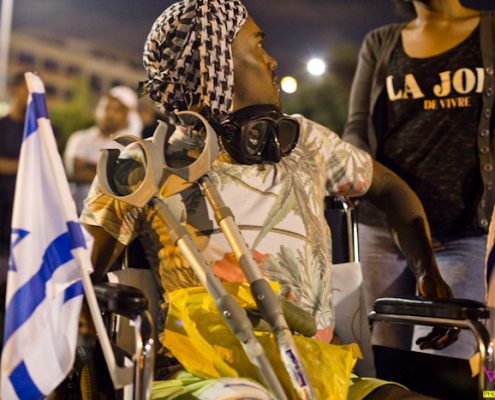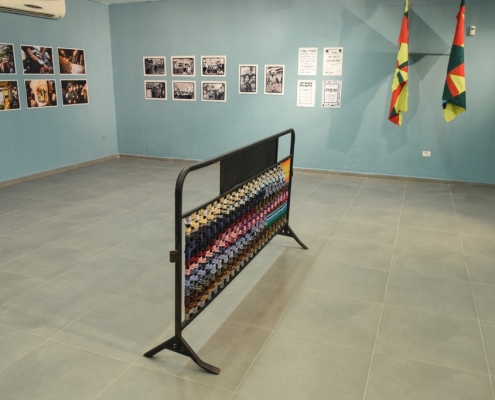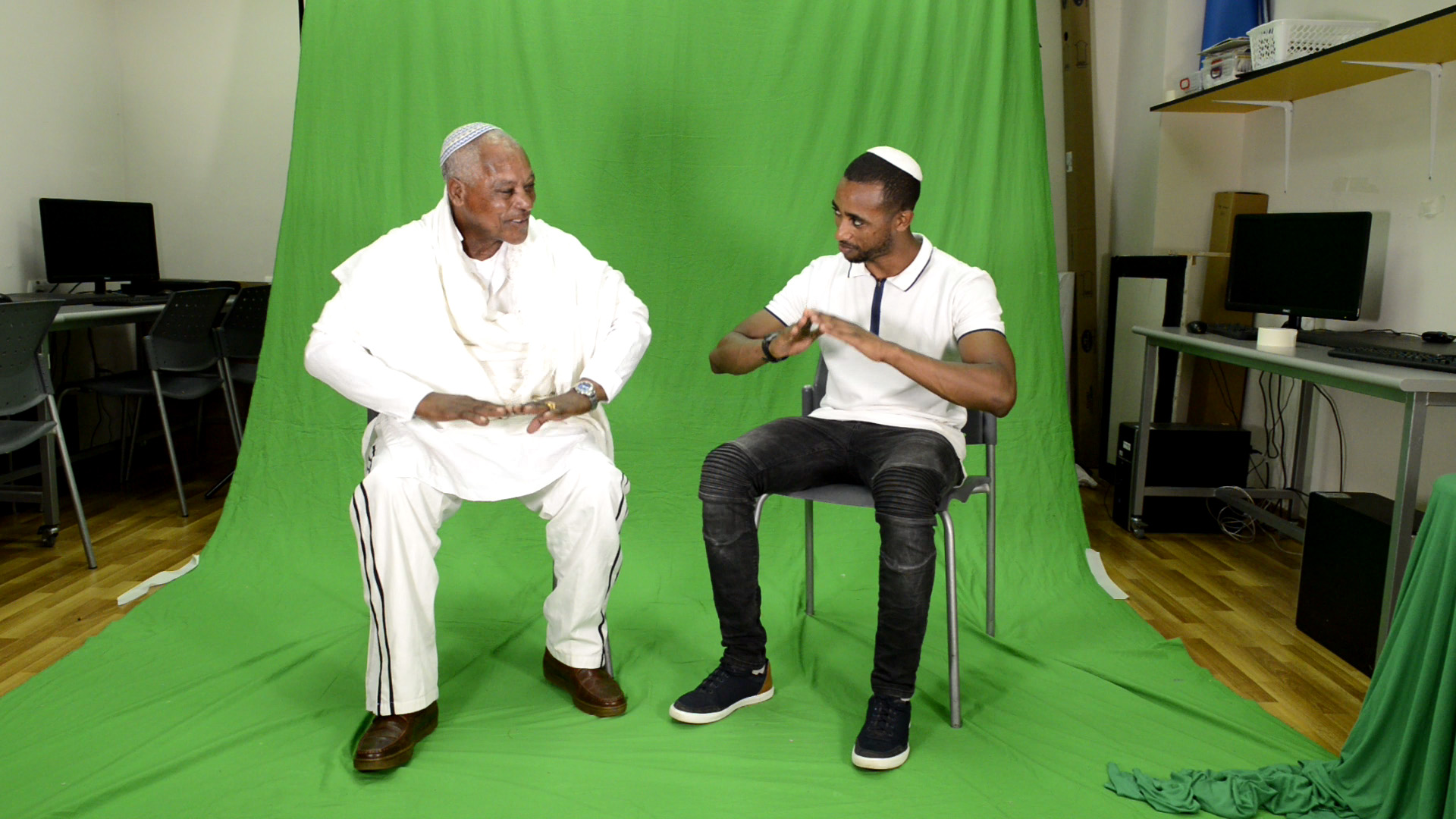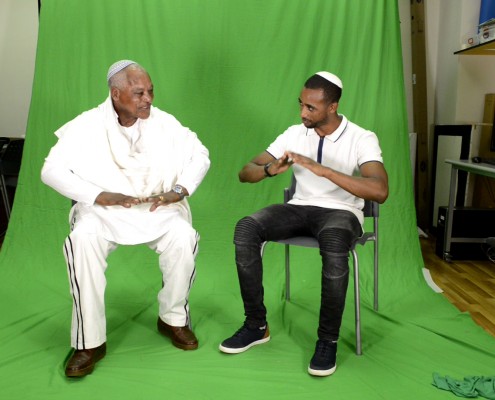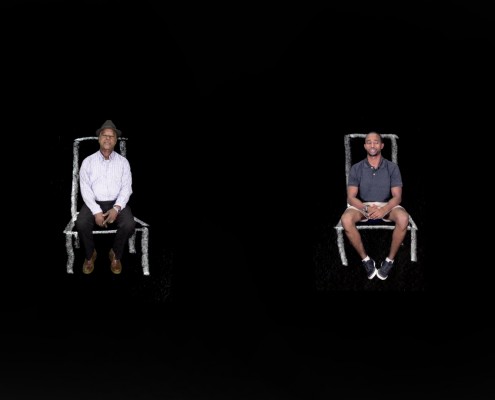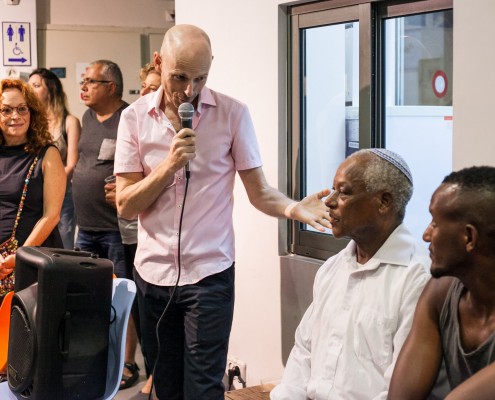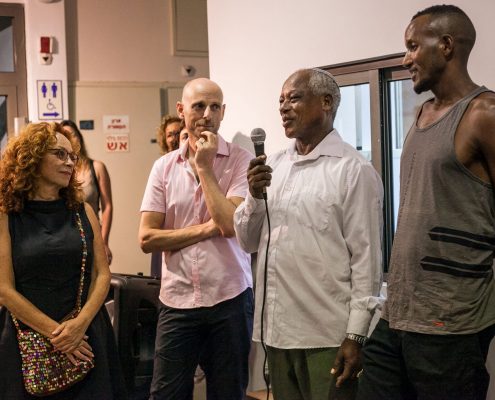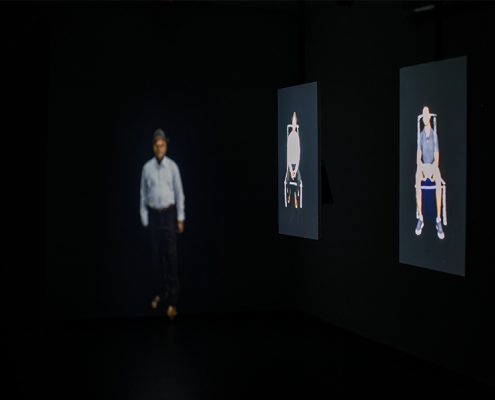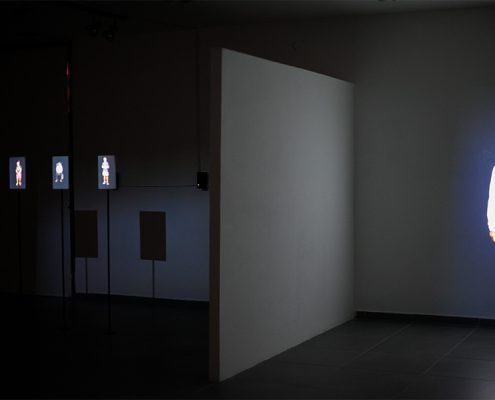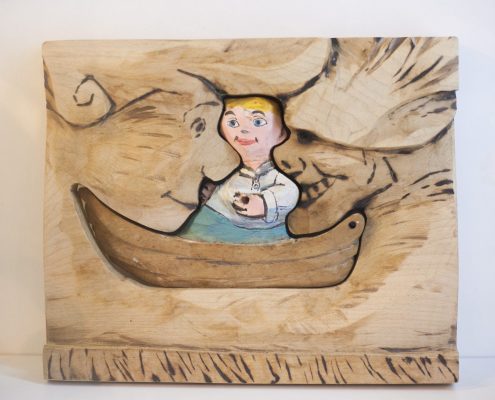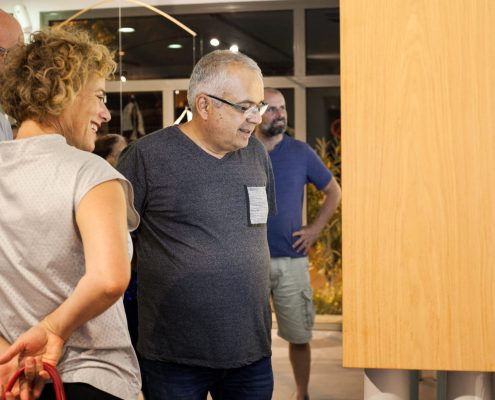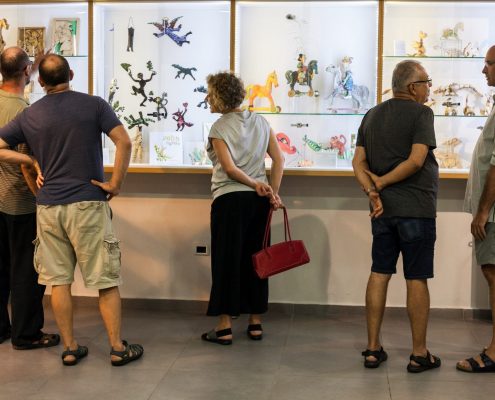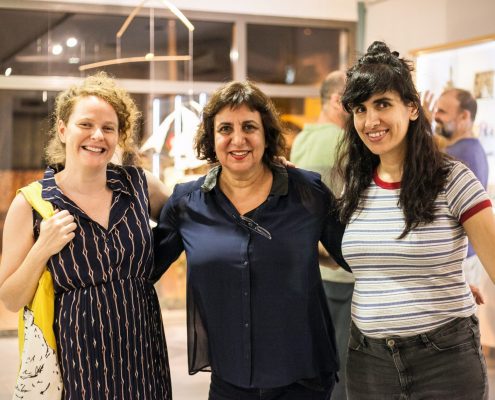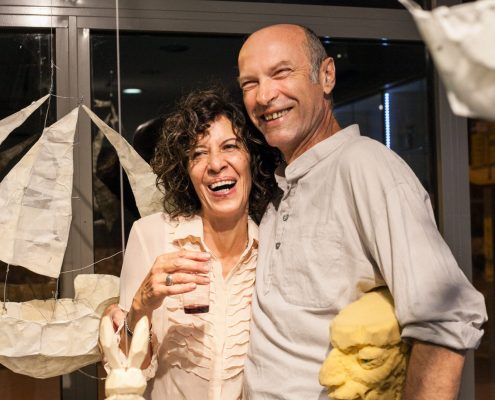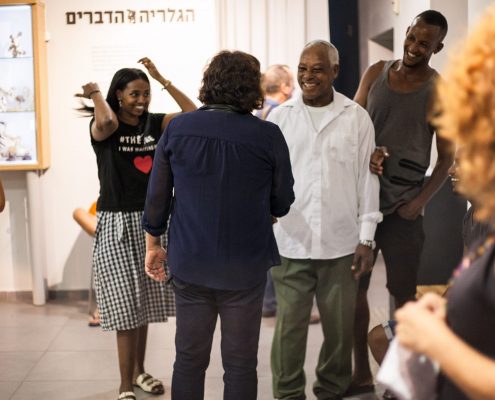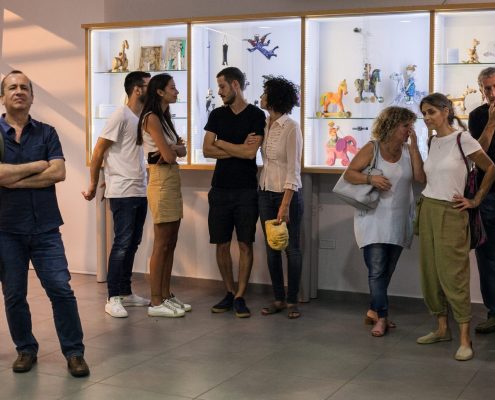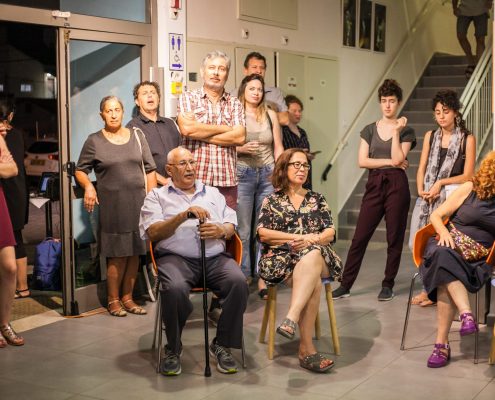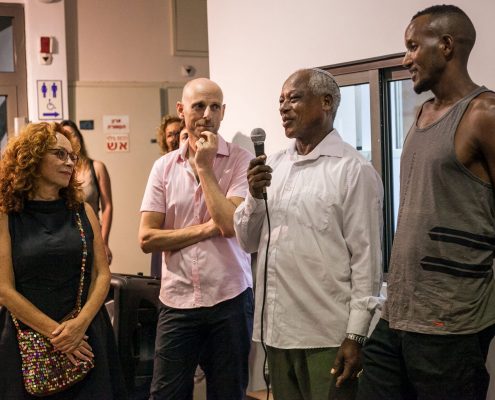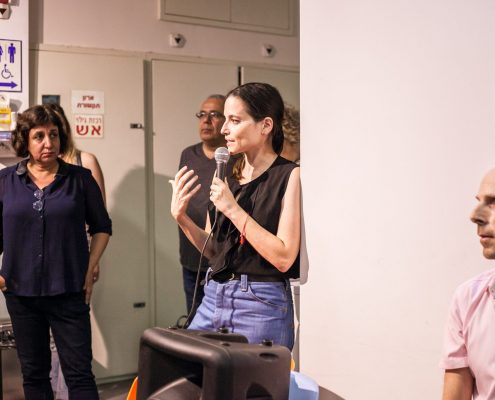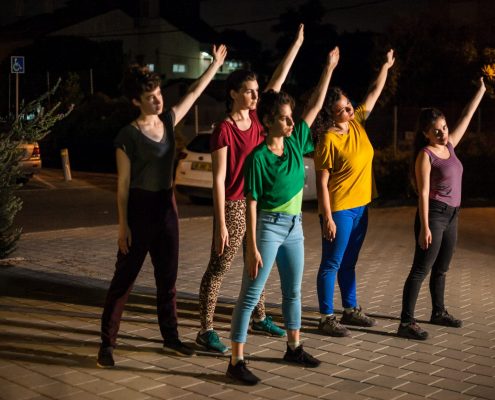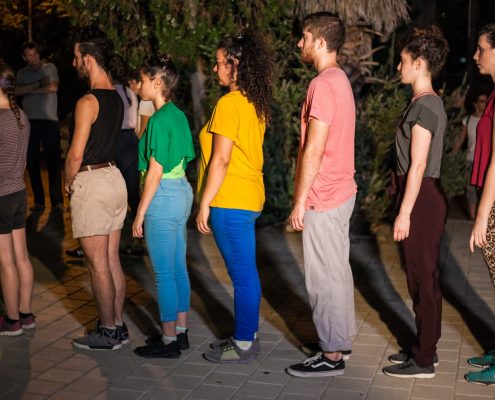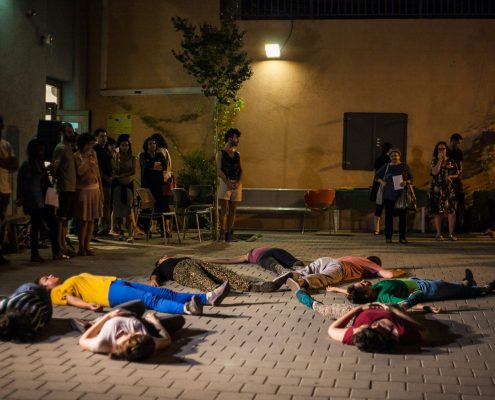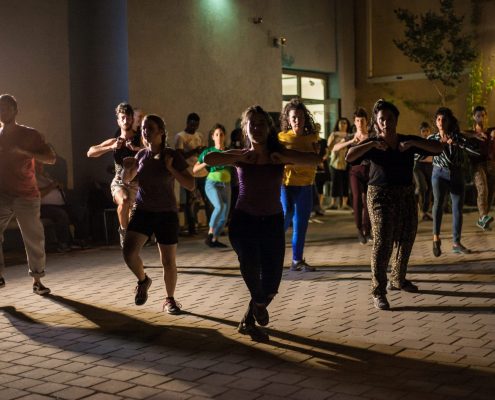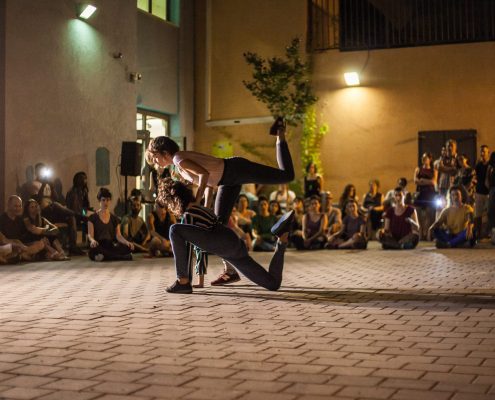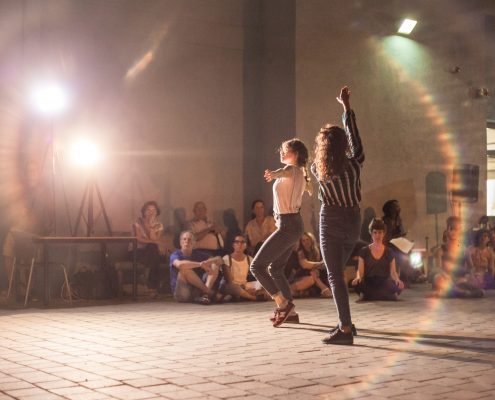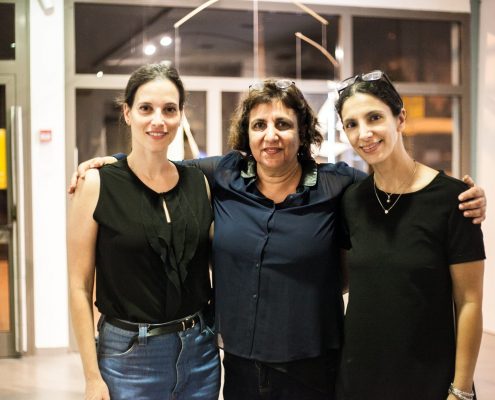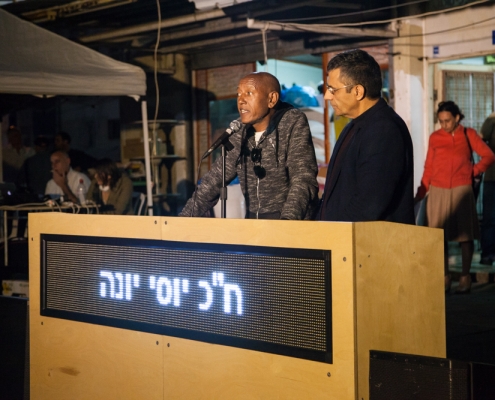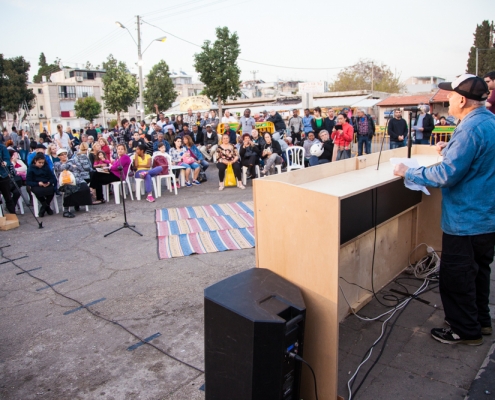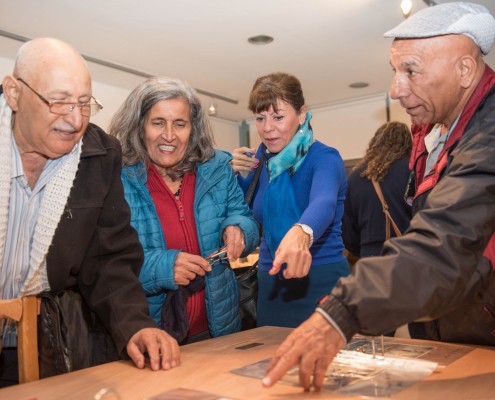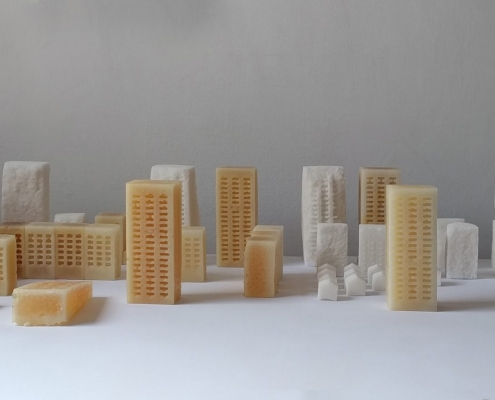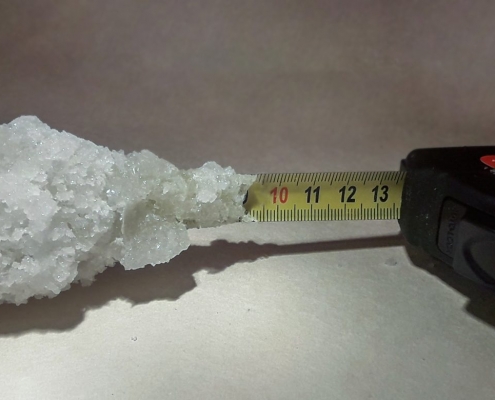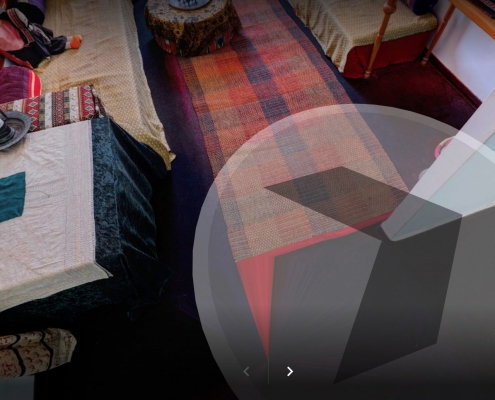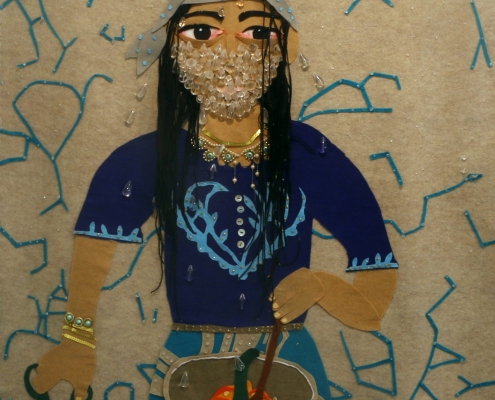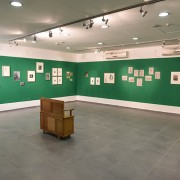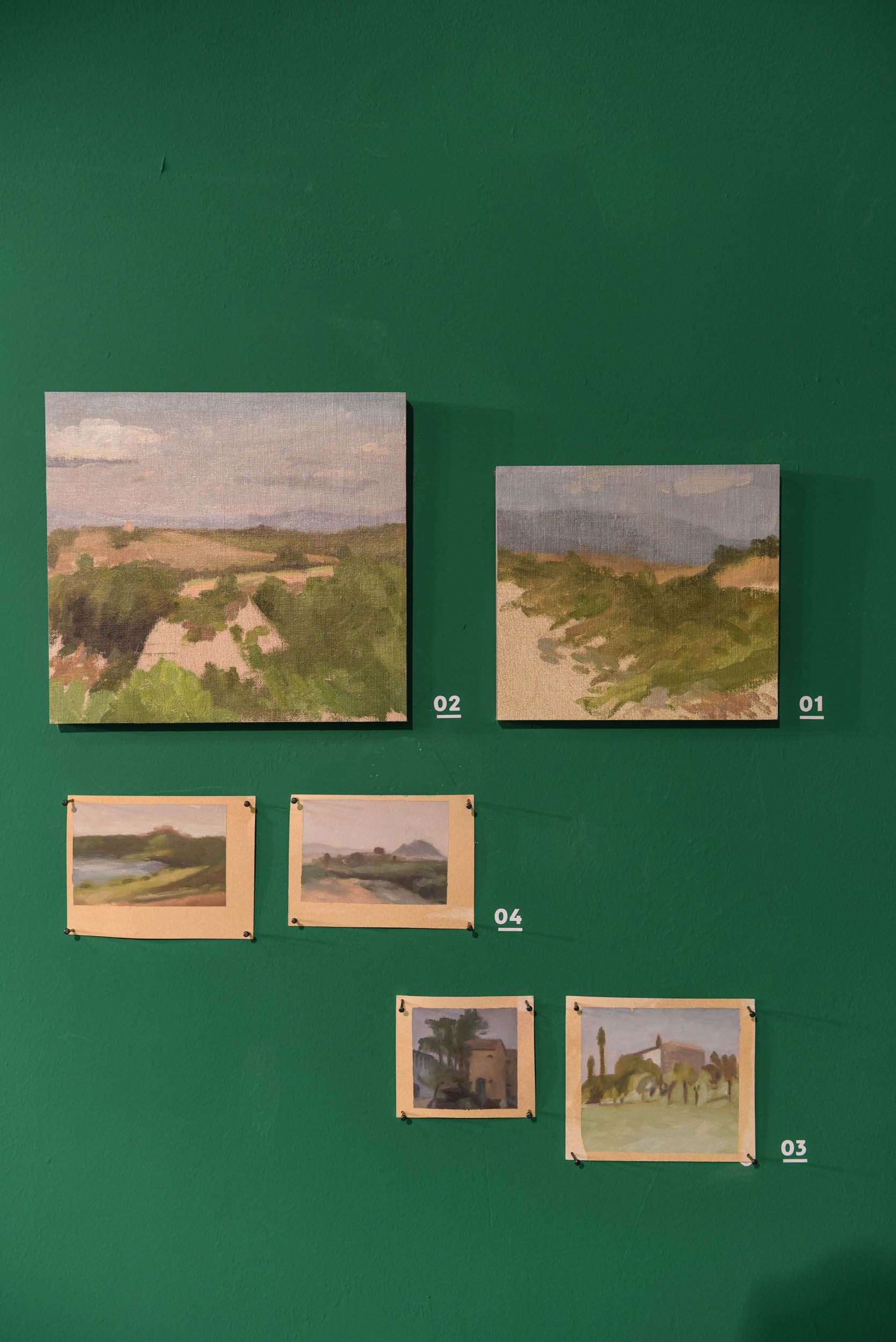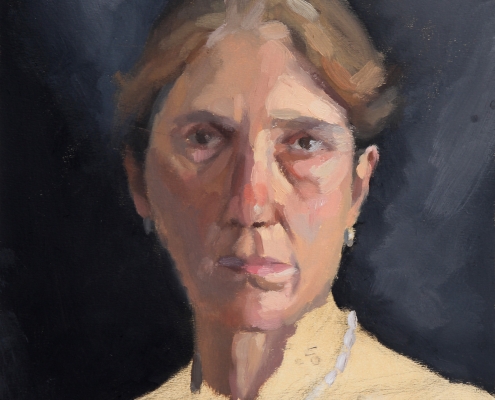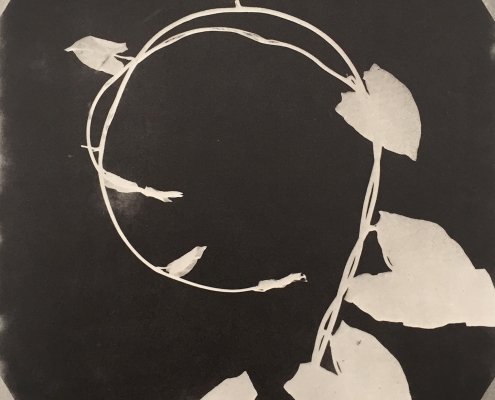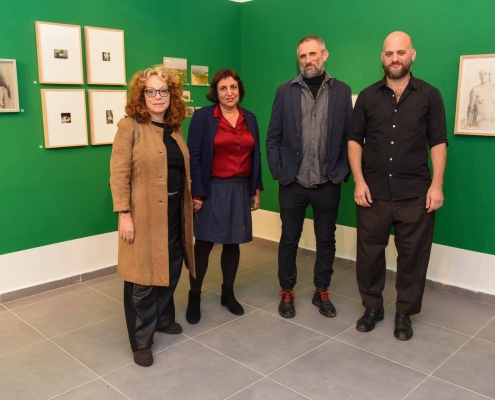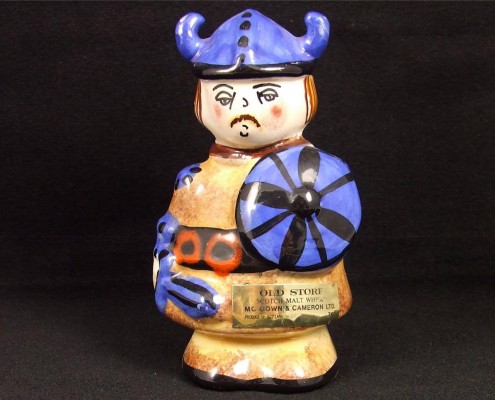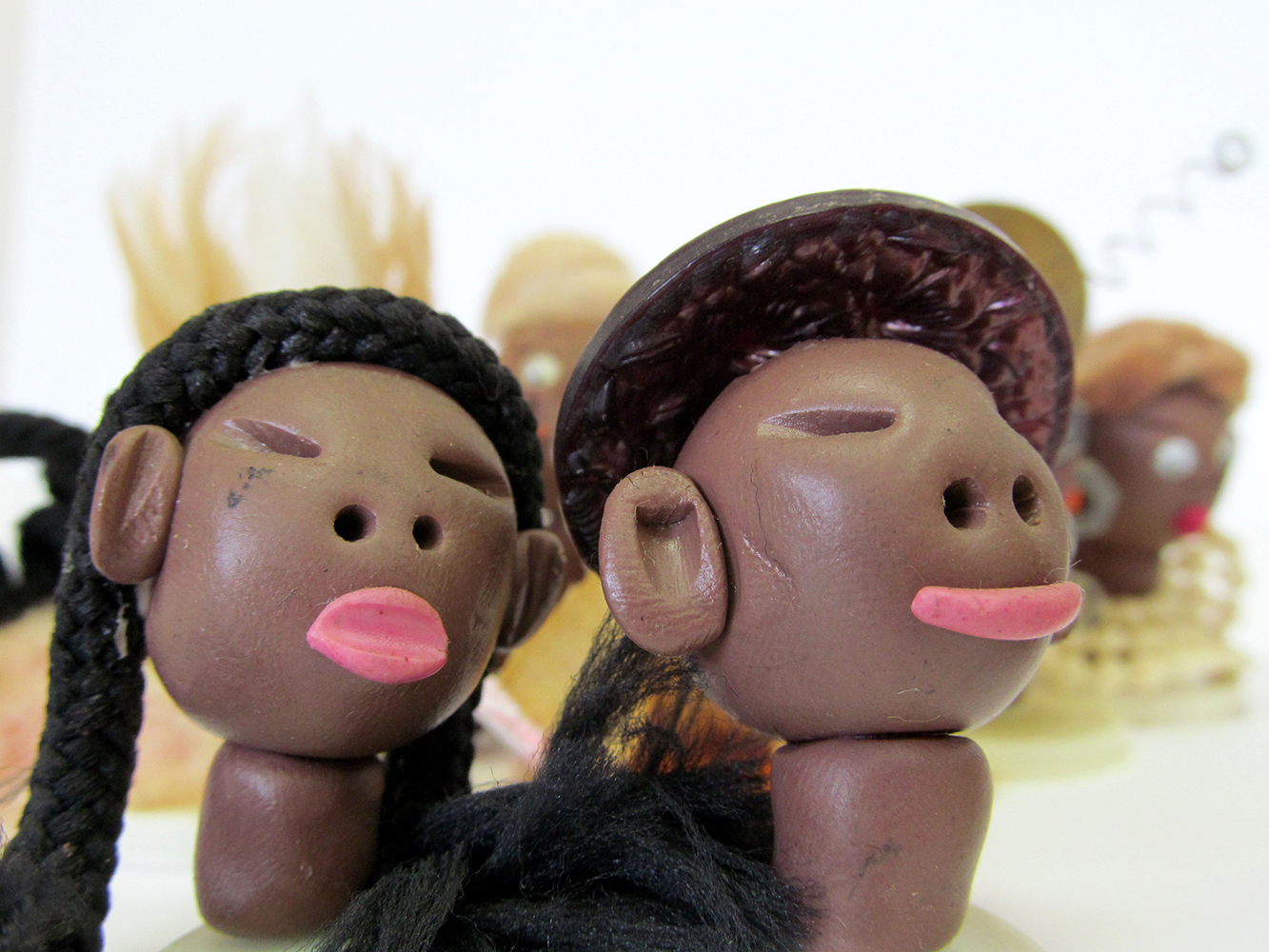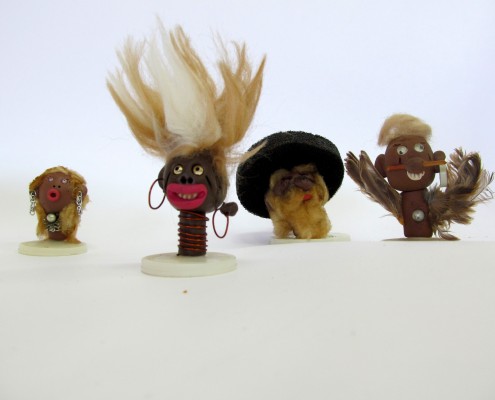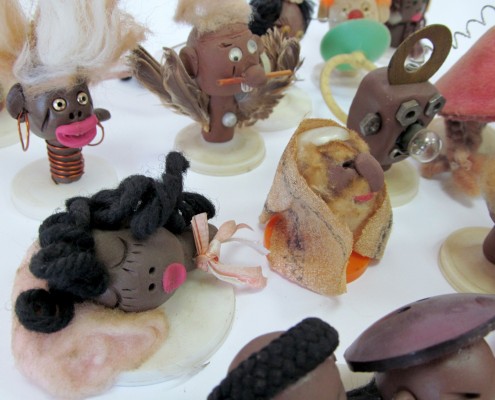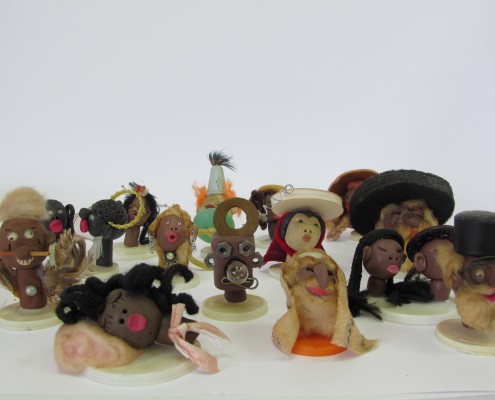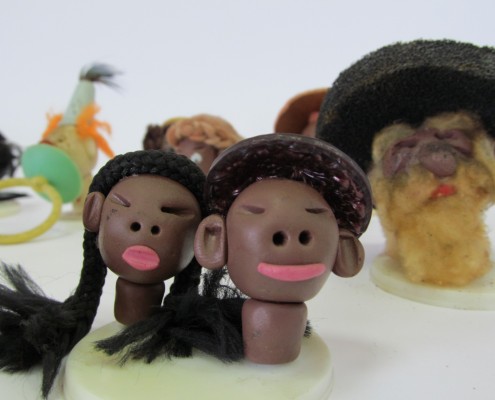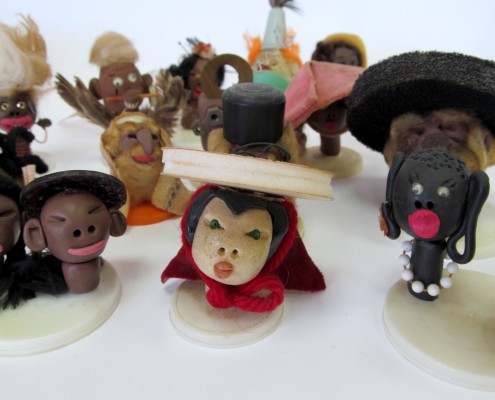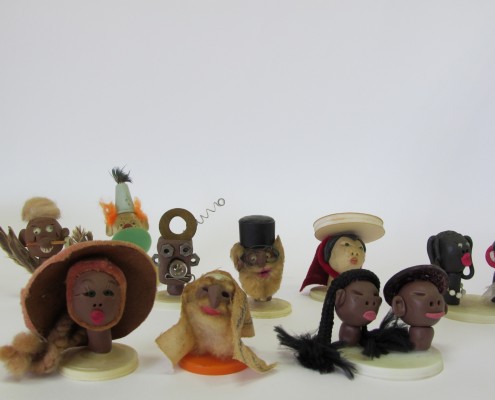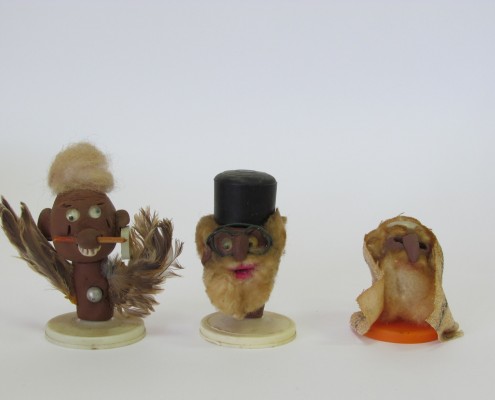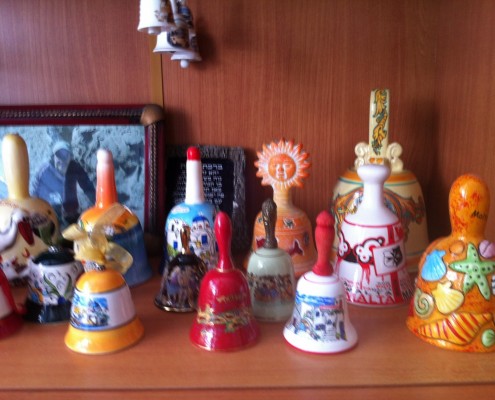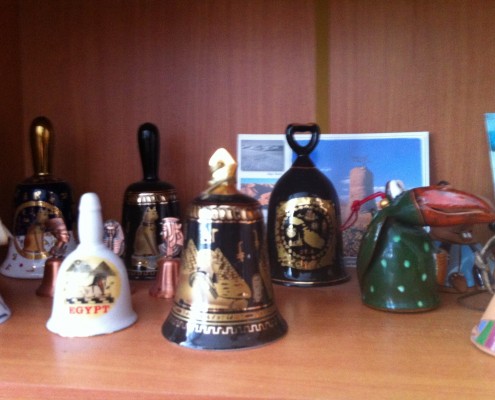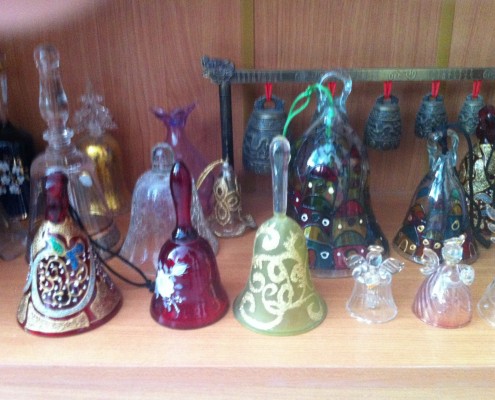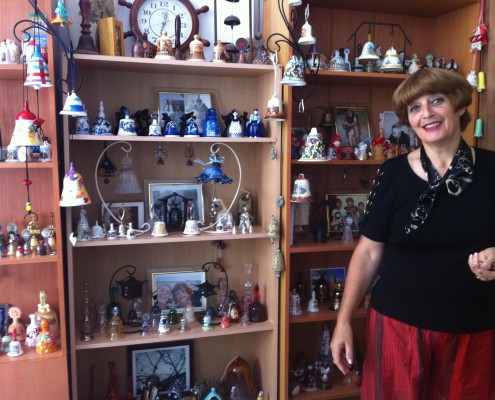איקס בעקבות מחאת יוצאי אתיופיה
/in ארכיון תערוכות, עבר /by art workshopהתערוכה החדשה בסדנא לאמנות תערוכה חדשה מפנה מבט למאבק יוצאי אתיופיה. כותרת התערוכה – “איקס X” מאזכרת את מחוות הידיים המוצלבות בהפגנות וגם את פעולת הפסילה, בין אם מדובר בפסילת מנות דם או בפסילה של דיירים למגורים.
בתצוגה: מחסומי משטרה ארוגים (ענבל אגוז), דגלים צבעוניים גיאומטריים מעולם של טקסים ותהלוכות (גילי אבישר), חולצת טריקו גדולת ממדים (גרעין קהילתי ראשל”צ בשיתוף מעצבת האופנה אפרת בנדיסלאב) וסדרות של צילומים (גדעון אגז’ה ומאיר ויגודר).
החלק הארי בתצוגה יוקדש לסדרת עבודות של הצלם גדעון אגז’ה, שתיעד את מחאת הצעירים בגליה השונים: במחוות הפרפורמטיביות ובאמצעות הצלבת הידיים בצילומי המפגינים שלו, מסמנים המצולמים כי הם אינם חמושים ואינם אלימים.
לצד סדרות צילומי המחאה יוצגו צילומיו של מאיר ויגודר משנות ה-70. ויגודר תיעד את מאבק הפנתרים השחורים ואת העימותים עם רשויות החוק וחלק מצילומיו צולמו אף הם באותו אתר ממש של בניין עיריית ת”א. הצילומים יופיעו כמעין הערה תקופתית, המאפשרת להציב את המחאה הנוכחית בפרספקטיבה של זמן ומקום. הצבה כזו בוחנת את נקודות הדמיון והשוני בהתקבלות או אי התקבלות של קבוצה, בהדרה מצד החברה ובתחושת אי-שייכות, ואת היחסים עם מוסדות החוק.
מחאת יוצאי אתיופיה רלוונטית לילידי הארץ הוותיקים כיוון שהיא שבה לאתגר את מושג “כור ההיתוך”, אחד הערכים הטעונים עליהם מושתתת החברה הישראלית מאז הקמת המדינה. המחאה היא גם הזדמנות להאיר את הנקודות בהן נפרמים ומתערערים החוטים העדינים, הדמיוניים, שניסו לכרוך קבוצות אתניות שונות עם המדינה ומוסדותיה.
בשנים האחרונות עסקו תערוכות רבות בפוליטיקה של הצבע, בהגירה ובעולים בעיקר סביב סממנים של תרבות ומסורת. תערוכות אחרות עסקו במחוות של מחאה ומופעיה הגופניים והצורניים במרחב הציבורי. התערוכה הנוכחית אינה הערה כללית על גזענות, על אחרוּת או על שחורוּת, אך היא כן מפנה מבט לקבוצה מסוימת של אזרחים הנוכחים במרחב הישראלי בזמן נתון. הם צועדים וחוסמים כבישים, ממלאים את הכיכרות והרחובות. שאלת ההתקבלות והנראות במרחב הציבורי נפתחת מחדש כשהקבוצה כמו תובעת מחדש את מקומה במרחב.
בתקופה זו בה אנו ערים ל”טעויות” בזיהוי ולשיפוט מהיר, על פי מראה וצבע עור, בימים בהם טעות בזיהוי מובילה לאלימות ולהרג של חפים מפשע, נשאלת שאלה על נראות, על דמיון חזותי ועל שוני על נאמנותה של קבוצה. תערוכה זו מסמנת ומבליטה את אזורי העימות שנצבעים דרך צבע, מוצאת ובוחרת להעלות קונפליקטים כאקט דמוקרטי, כשהיא חותרת תחת טיוח ההבדלים והישראליות של כור ההיתוך.
פתיחת תערוכה : 9.4.2016
אמנים : גדעון אגז’ה, גילי אבישר, מאיר ויגוזר, ענבל אגוז.
אוצרות : אורית חסון
רחל נבון
/in הגלרייה של כל הדברים, עבר /by art workshopשירת גברים, תערוכה | Men Singing , Exhibition
/in אירועים קהילה, ארכיון תערוכות, גלריית הסדנא לאמנות, עבר /by art workshopשירת גברים / מישל פלטניק
אוצרת: אורית חסון ולדר
*English follows below
רקיעות ברגליים, מחיאות כפיים ושירה הם רק חלק מרפרטואר המחוות במיצב הווידיאו של האמן מישל פלטניק, אשר נוצר במיוחד לגלריית הסדנא לאמנות.
כשהם ישובים או ניצבים, צועדים במקום או עומדים, משחזרים שלושת הגברים שירים וסיפורים ששמעו בילדותם ובצעירותם. שם התערוכה רומז לאיסור על שירת נשים והדרתן ממקומות ציבוריים, שעולה לכותרות בתדירות הולכת וגדלה, ומולו מוצבת דווקא שירה אזרחית של גברים במרחב הפרטי. אל מול אפליה של נשים והדרתן מהספרה הציבורית מספר האב דווקא על תחושות של הזנחה שחש כגבר עולה בקהילה האתיופית ביחס לטיפוח הנשים בנות הקהילה.
התערוכה מוקדשת לגברים בני דורות שונים מן הקהילה האתיופית הנוכחים בחלל בקולם ובשירתם. בפינות שונות בחלל החשוך הם “מאירים” כמו גחליליות על יחידות הקרנה אינטימיות. האובייקטים (מוטות מתכת דקיקים) משתלשלים מן התקרה וכמו צומחים מן הרצפה ומזכירים בגודלם ובצורתם משוטי סירה. בחלק ממיצב הווידיאו נעצרת התנועה ושני הגברים נותרים קפואים לכמה שניות בעוד האדם השלישי ממשיך לשיר ולזוז ולהפך. כמו בשחזור אירוע היסטורי, גם כאן קיימת חזרה מאוחרת לסיטואציה מהעבר אשר נחרטה בזיכרון. השחזור באמצעות הדימוי הנע מקיים חזרה כפולה: הגברים חוזרים אל הרגע בילדותם והוא מוקלט בשנית. האדם אשר נטל חלק באירוע המוקדם מעניק לו למעשה משמעות חדשה. כך שירת הבנים שנולדו בישראל או עלו אליה, מעניקה פרשנות מחודשת לטקסטים של השירים. הופעתם מחדש שרים באמהרית, כגברים צעירים הגאים בתרבות האם ודוברי השפה, מהווה פעולה אישת כמו גם פוליטית.
פלטניק, עולה מצרפת, עוסק במרבית עבודותיו ביחסים בין אבות ובנים ומבקש לפענח יחסים בין דוריים חוצי יבשות וארצות באשר הם. הצטלבות הביוגרפיה של המהגרים הצעירים מאתיופיה ותהליך ההגירה השונה מאוד של האמן חושפת את רגעי המעבר וההחלפה של שפת ארץ המוצא בשפה העברית. העבודה שואלת מה נרשם בזיכרון, מה ניתן להעביר ולתווך בשפה אחרת לעומת מה שנשמט בדרך ואובד.
עבודת הווידאו בהשתתפות: בלאי אבבה, ג’מרה אבבה, אגר אספה\
בגלריה של כל הדברים: מייפל ואגוז
ב”גלריה של כל הדברים”, חלל תצוגה מחוץ למעגלי האמנות ובהשראת חדרי הפלאות, מציב בוריס קרביץ, מאייר ומעצב תפאורה, צעצועי עץ שחלקם קשורים לעולם הילדות ומקצתם אינם תמימים וילדיים כלל. בין פסליו: דמויות של לוחם, בעלי חיים ומטריושקה בדמותו. בארון מוצבת גם עבודה הנושאת גוון פוליטי ונושאת את השם “צב הריסה”, מעין הכלאה בין צב לדחפור הריסה. קרביץ מתייחס בעבודה לחוויה שחווה בביקוריו בבקעה אצל חקלאים ערבים ולצווי הריסה הניתנים למשפחות רועי הצאן בצפון בקעת הירדן.
בערב הפתיחה יתקיים מופע המחול: צורת תרבות של חברי קבוצת תרבות עם הכוריאוגרפית רננה רז העבודה, שהחזרות עליה נערכו בסטודיו בסדנא לאמנות ,עוסקת בצורות וחוקרת את ההיבטים הכוריאוגרפיים ואת ההקשרים התוכניים והרגשיים הגלומים בצורות: צורות כאובייקט גיאומטרי וצורות כשיקוף וייצוג של רעיונות או ערכים. העבודה בוחנת כיצד אנו מתבוננים בצורות, את האופן בו צורות נחוות בראי הזמן .העבודה שואלת באילו צורות מתלכדות קבוצות ובאילו הפרט ומה קודם למה רעיון לצורה או צורה לרעיון.
רקדנים: אדר רוני, אייזנר נדב, ברקן זואי, גל דורין, לובין מיכל, לניר גילי, מוכיח שקד,מנטל מאיה, רגב לבנה, רוזנברג מעיין ושחר שיבולי
על רננה רז – רננה רז: כוריאוגרפית, רקדנית ויוצרת רב-תחומית עבודתה מאופיינת במקוריות ובחדשנות. ביצירותיה משלבת דיסיפלינות שונות כתיאטרון ופרפורמנס. בעבודותיה בוחנת את מקומו והשפעתו של ההקשר על האופן בו מתקבל התוכן. זוכת פרס שר המדע התרבות והספורט ליוצרים צעירים לשנת 2002,2003,2006. זוכת פרס רוזנבלום לשנת 2006.
בין עבודותיה: YouMake ReMake הכולל תגובות מבוימות לקטעי יוטיוב המתרחשות על הבמה, ‘השימוע’, אירוע תיאטרלי בעקבות פרשת המורה אדם ורטה, יצירותיה מוצגות בארץ ובעולם.
Men Singing / Michel Platnic
Curator: Orit Hasson Walder
The festive opening reception was held on Sat. evening, Sept. 1, 2018
***
Men stamping their feet, clapping hands, and singing are only some of the repertoire of gestures in artist Michel Platnic’s new video created especially for the Ramat Eliyahu Art Workshop Gallery.
Whether sitting or standing, marching or standing in place, the three men present songs and stories recalled from childhood and youth. The title of the exhibition hints at the prohibition of men hearing singing by women, and the women’s exclusion from public spaces, on the rise in headlines in Israel. In contrast are the songs by male laymen in the private space. When referring to the exclusion of women, the father narrates a story about his feelings of being neglected by the community as a male immigrant from Ethiopia, since it is the women who are mostly being nurtured by the women of the community.
The exhibition is devoted to the multiple generations in the Ethiopian community present in the space through their voices and singing. They “illuminate” various corners of the darkened space like fireflies as the spotlights shine on them, creating intimate spaces. The size and shape of the thin metal rods slinking down from the ceiling and which seem to grow out of the floor are reminiscent of oars. In some sections of the video, two out of the three men are “frozen” for a few seconds while the third continues to sing and move, and vice versa. As in a re-enactment of an historical event, here, too, the men re-enact a past situation imprinted in their memories. The re-enactment by the moving figure is a double repetition: the men repeat the moment from their childhood, which is then re-recorded. The man who participated in the earlier event adds a new meaning to the event. Songs by the sons born in Israel or who immigrated to Israel provide a new interpretation to the texts. The reappearance of these songs in Amharic sung by young men, Amharic speakers proud of their mother tongue and cultural heritage, constitutes a personal as well as a political act.
Michel Plotnic, a multidisciplinary artist who immigrated from France, engages in intergenerational relationships, seeking to decode relationships crossing continents and countries in most of his works. The juncture of the biography of the young immigrants from Ethiopia with the artist’s own very different biography exposes the moments of transition and replacement of one’s native language with Hebrew. The video interrogates memory, what and how it is recorded, what can be transmitted and mediated in another language compared to what is left out on the way and lost.
Participants in the video: Belay Abeba, Jamara Abeba, Agar Asepa.
***
In the Gallery of All Things: MAPLE & WALNUT
The Gallery of All Things is an alternative exhibition space in the spirit of the 19th century “cabinet of wonders.” Boris Kravitz, illustrator and costume designer is exhibiting wooden toys, some of which are associated with childhood while others are not at all innocent or childish. Among his sculptures are warrior figures, animals, and a self-portrait on a matriyushka – nestling dolls. In the cabinet is a political work with the title a pun in Hebrew – Demolition Order / Turtle, a hybrid between a turtle and bulldozer used for demolition. Kravitz refers to his experience in Baka-al-Gharbiyeh visiting Arab farmers, and witnessing the demolition orders given to sheep-herding families in the northern Jordan Rift.
***
Opening night featured Culture Form/ Tzurat Tarbut by Choreographer Renana Raz and dancers from the Tenuat Tarbut/Cultural Movement dance group.
Rehearsals were held in the studio at the Ramat Eliyahu Art Workshops site for this work engaged in forms, studying the choreographic, emotional, and content associations embodied in forms: forms as geometric objects and as reflecting and representing ideas or values. The piece examines how we observe forms, asking which came first – the idea or the form? In what forms do groups take shape, and in which details and ways are forms experienced as seen through time?
Dancers: Roni Adar, Nadav Eisner, Zoe Barkan, Doreen Gal, Michal Lubin, Gili Lanir, Shaed Mochiah, Maya Mantal, Levana Regev, Maayan Rosenberg, Shahar Shiboli
Renana Raz: Choreographer, dancer, multidisciplinary creative artist, her work is characterized by originality and innovation. Raz integrates various disciplines such as theatre and performance in her dance, examining the place and impact of context on the way in which content is accepted. Awarded the Minister of Science, Culture and Sport Prize for a Young Artist for 2002, 2003, and 2006. Her works include “YouMake ReMake,” with staged responses to YouTube clips onstage, and “The Hearing,” a theatrical production based on the affair of the teacher Adam Varta. Renana Raz’s works are presented in Israel and abroad.
טרזן על סדין, תערוכה | Tarzan on a Sheet , exhibition
/in Uncategorized, ארכיון תערוכות, גלריית הסדנא לאמנות, עבר, עמוד ראשי, תערוכות /by art workshopטרזן על סדין הסדנא לאמנות רמת אליהו 2017
אמנים : יעל בן שלום, ליאור גריידי, צאלה גרינברג, עומר קריגר, הלל רומן
‘בחלון אמנית: נועה טורקניץ
אוצרת: אורית חסון ולדר
*English follows below
שם התערוכה “טרזן על סדין” נשען על זיכרון ילדות של ותיקי שכונת רמת אליהו שצפו בסרטי “טרזן” ו”זורו” שהוקרנו על סדינים במרחב הציבורי של השכונה. לתערוכה קדמו פעולות אמנות ציבוריות שנערכו בשכונה במסגרת פסטיבל ״פינוי בינוי תתחדש אליהו״ ואחריו.
התערוכה מבקשת לבחון מה קורה להיסטוריה ולמיתולוגיה מקומית בעיבוד למדיום ולדור אחר ובאילו אופנים ניתן לעסוק בחומרי ארכיון מבלי להיתפס לנוסטלגיה. בנוסף ייבחן הפוטנציאל הקיים במפגש של אמנים עכשוויים עם עדויות וזיכרונות של המורשת העדתית לייצור תרבות חיה ופועמת.
במסגרת התערוכה מוזמנים התושבים להתארח במיצב מיוחד שנבנה בשיתוף ותיקי השכונה, מוצבים בניינים עשויים סוכר שנתרם על ידי תושבי השכונה ותלויים על החלון דגלים בהשראת סיפוריה של תושבת השכונה רינה, ששמה הוחלף במצוות בעלה לשרה כדי שיביא מזל טוב.
בעבודת וידיאו שנערכה במיוחד מתועד אירוע של שידור חי” של “רדיו קול המדינה הבאה” פעולה ציבורית של האמנים עומר קריגר והלל רומן (במסגרת “פסטיבל פינוי בינוי- תתחדש אליהו) בוידיאו ניתן לעקוב אחרי רצף של דיונים בעברית וSaveבאמהרית בין הדוברים נציגי מנהלת פינוי בינוי, קס סמאי אליאס – קס העדה בראשל”צ, ח״כ יוסי יונה – המחנה הציוני, ממקימי הקשת הדמוקרטית המזרחית ותושבי רמת אליהו.
בעבודתה של יעל בן שלום יוקרן על גבי מסך מגע סיור וירטואלי במוזיאון למורשת יהודי תימן. המוזיאון, שהוקם ב-1970 על ידי סבה של האמנית בנתניה ונותר כמעט ללא שינוי מאז, צולם ב-360 מעלות על ידי צלם מוסמך של google street view באופן שמאפשר לצופה לשוטט בו בלי להיות נוכח במקום פיזית. העבודה מבקשת לעורר שאלות אודות תפקיד המרחב הפיזי של מוזיאון מורשת בימינו ויחסי הגומלין בינו לבין המוזיאון המדומיין המוצג לצופה בגלריה.
המיצב של צאלה גרינברג מציע דגם של שכונת רמת אליהו העתידית. הדגם עשוי כולו מסוכר ונוצר בהשראת דיווחים וכתבות שהתפרסמו בשנים האחרונות בעיתונים ובאתר העירייה סביב תכנית הפינוי בינוי. הסוכר ששימש חומר גלם ליצירה נאסף על ידי האמנית בתרומה מדלת לדלת. תהליך האיסוף מתועד בסרט שמהווה חלק מהמיצב, שנע בין ניסוי קולינרי בסוכר וניסוי מדעי במצבי צבירה משתנים.
האמן ליאור גריידי הציב במרחב הגלריה שולחן שתכנן בשיתוף עם ותיקי השכונה: יוסף גולן,סעדיה גרמי,איציק ששון ומרדכי ברזילי .השולחנות, המאזכרים שולחנות בית ספר, יזמנו סיטואציות של אירוח אשר במסגרתן יפגשו התושבים על כוס קפה ויאספו חומרים ארכיונים, כשהתושבים הוותיקים משמשים כספרנים ומידענים. על השולחן חקוקים שמותיהם וכינוייהם של הוותיקים (איציק קלרה, דני חסיבה) שמביאים לידי ביטוי תופעה בה הם החליפו את שמות משפחתם המסורתיים בשמות אימותיהם, שהיו הדומיננטיות במשפחה.
בחלון אמנית הפונה לרחוב תציג נועה טורקניץ’ עבודה הבנויה משני חלקים בטכניקה מעורבת המזכירה שמיכות טלאים ,מעין דגלים ארוכים שנוצרו בהשראת סיפוריה של תושבת השכונה ילידת 1920 רינה (שרה) נתן המייצרים מיתולוגיה ייחודית לה וליוצאי תימן בתקופתה.
Tarzan on a Bedsheet
Ramat Eliyahu Art Workshop, 2017
In the Gallery: Yael Ben Shalom, Leor Grady, Tseela Greenberg, Omer Krieger, Hillel Roman
In the Artist’s Window: Noa Turkenitz
Curator: Orit Hasson Walder
The exhibition Tarzan on a Bedsheet is based on the childhood memories of the old-timers of the Ramat Eliyahu neighborhood of watching Zorro and Tarzan films on improvised screenings on bedsheets in the neighborhood’s public spaces. Preparations leading up to the exhibit included public art actions in the neighborhood before, during, and after the Pinui/Binui Festival referring to the neighborhood renewal project.
The exhibition is an attempt to examine what happens to local history and mythology when processed in a different medium by a different generation. In what ways can we engage in archival material without falling into the trap of nostalgia? The artists further explore the potential to create a living, breathing culture existing in the encounter between contemporary artists and testimonies and memories which are part of the heritage of a particular ethnic community.
The exhibition invites local residents into a special installation constructed in collaboration with the neighborhood old-timers, comprising buildings made of sugar cubes contributed by local residents. Flags inspired by Rina’s stories hang in the windows, including Rina’s own story of how her husband ordered her to change her name to Sarah to bring good luck.
The public art actions by Omer Krieger and Hillel Roman as part of the Voice of the Future State Radio Station – Kol Hamedina Habaa, are been documented in a video-art piece edited especially for the exhibition. It depicts the live-streaming event held during of the Pinui/Binui Festival on Neighborhood Renewal, especially discussions in Amharic and Hebrew between representatives of the Pinui/Binui Neighborhood Renewal administration, Kes Samai Elias, religious leader of the Ethiopian community in Rishon Lezion, and between MK Yossi Yonah of the Mahaneh Hatzioni, one of the founders of the Eastern Democratic Rainbow, and local residents.
Yael Ben Shalom’s work will be screened on a touch screen in the Museum of the Heritage of Yemenite Jewry, founded in 1970 in Netanya by the artist’s grandfather. It has hardly changed since them. The 360° photography was filmed by an authorized photographer of Google Street View, enabling viewers to go on a virtual tour of the Museum without being physically present. Ben Shalom’s artwork seeks to arouse questions on the function of a heritage museum in this day and age and the reciprocal relations between the image of the museum presented to viewers in the gallery space.
Tseela Greenberg presents an installation proposing a model of the future Ramat Eliyahu neighborhood, made entirely of sugar, created in the wake of reports and features in the press in recent years and posted on the Municipality’s website on the neighborhood renewal project which intends to clear out residents and rebuild it. The sugar was gathered in door-to-door donations by the artist, a process documented in the film which is part of the installation, part culinary experimentation with sugar and part scientific experiment with changing physical states of material.
Leor Grady’s table placed in the gallery space was designed by the artist in collaboration with veteran neighborhood residents Yosef Golan, Saadia Garami, Itzik Sasson, and Mordechai Barzilai. The tables, reminiscent of schoolroom desks, invoke situations of hospitality. During these encounters, residents can meet over a cup of coffee, collect archival materials, encounters in which the old-timers act as librarians and information technologists. The veteran residents’ names and nicknames cut into the tables (Itzik Clara, Danny Hassibah) reflect the phenomenon of people changing their traditional family names to bear their mother’s name, as the mothers were dominant in the families.
The Artist’s Window facing the street showcases Noa Turkenitz’s work in mixed media made in two sections, bringing to mind patchwork quilts. They form what look like long flags, inspired by Rina (Sarah) Natan, a local resident born in 1920, creating a mythology unique to Rina and other of her contemporaries who are part of the Yemenite community.
לא חשוב לא חשוב , תערוכה | It’s not important, doesn’t matter , Exhibition
/in אירועים קהילה, עבר, עמוד ראשי, תערוכות /by art workshopלא חשוב לא חשוב, עלמא גרשוני ואורי גרשוני, הסדנא לאמנות רמת אליהו, אוצרת : אורית חסון ולדר
* English follows below
“בבית הספר הייתה לי הפתעה דוד פרה שאני אוהבת בא לקחת אותי.” כך מתחיל הטקסט שנכתב לפני 15 שנה וכך ממשיך: “ועכשיו אמרתי לדוד פרה את כל מה שכתבתי עכשיו ועכשיו אמרתי לו את כל מה שעשינו עד עכשיו וגם הזכרתי לו מה לכתוב וצרחתי עליו: לא חשוב לא חשוב“.
בתערוכה המשותפת לעלמא גרשוני ולאורי גרשוני הם חוזרים לעבודה משותפת שיצרו לפני 15 שנה והיא מהווה עוגן קונקרטי לתערוכה. ביצירה זו יש, לדבריהם, רגע מכונן בו הובן מעשה היצירה בהקשר לזמן ומשך והכרה בכך שהרגע עליו מדווחים הוא לעולם הרגע שאחרי. לצד נוכחות העבר מתקיים עכשיו מפגש בזמן הווה וממשיך את העיסוק בעבר, ב”תולדות” וב”אבות האמנות והצילום”.
זו אינה עוד תערוכה רכילות משפחתית על שושלת גרשוני, גם לא תערוכה בנוסח: “אבות ובנים” אך עם זאת הקשר המיוחד בין אורי הדוד ועלמא האחיינית הוא מרכיב חשוב בהתהוות התערוכה.
חלל הגלריה הופך למעין “מוזיאון זוטא” בו המוצגים מקוטלגים וממוספרים ויש בו דגש על אופני התצוגה ולא רק על האובייקטים האמנותיים. התלייה המעורבת טווה חוטים בין האוסף של אורי לבין הציורים של עלמא ובמרכזה יחסי ציור וצילום והחשדנות ההדדית בין המדיה.
ריבוי המודלים, ה”טבע דומם”, דיוקנות ושאר הנושאים עובדים ככלי משחק השאולים מתולדות האמנות ולעולם של מאסטרים בציור וצילום: טורסו, פסלים יווניים, העתקים של יצירות מקור, כל אלו מזמינים מחשבה אודות מתודה ותרגול של ציור. התערוכה מציעה מחשבה חדשה על חיקוי, על שיכפול ועל חזרה, כשצילום וציור מהדהדים אחד את השני.
אורי, הצלם מופיע הפעם, כבעל האוסף, בתפקיד המשמר, המקבע, זה שלוכד דימויים, והופך כדבריו “דבר זר לשלו”, כך הוא מציג צלמים יידועי שם: וויליאם הנרי פוקס טלבוט, נדאר, לני ריפנשטאל לצד צלמים אנונימיים שהוא אוהב שהקשר שלו עם תצלומיהם גם הוא אינטימי. הצגת האוסף הוא צעד נוסף הממשיך מהלכים קודמים בהם אורי צילם את הבית של טלבוט מאבות הצילום ומהלכים של חזרה לטכניקות מראשית ימי הצילום.
עלמא ציירת ריאליסטית שזו לה תערוכת בכורה מציגה רישומים, ציורי שמן ועבודות בטכניקת גריזיי ובהן פורטרטים, ציורי נוף וטבע דומם. גם כשהיא ניצבת מול מודל נתון מראש, היא מטעינה אותו בנשימה נוספת משלה. המבט שלה חודר את שכבות המודל המחזיר(ה)לה מבט .היא “מחייה” במכחולה קבקבים אדומים, מעירה מודליסטיות מנומנמות משנתן ובעבודותיה נוכח תמיד משהו נוסף שהיא מראה לנו: זווית פה מעוקמת, עגמומיות קלה כשהמקצב הרישומי, ציורי שלה מצטרף ל”ראיית הרנטגן” .עלמא לעולם מתרגמת לנו הצופים ללא חנופה ושיקולים אסתטיים של טעם טוב, ומוסרת מצג נתונים של מה שראתה ברגע שלפני.
כשעלמא היתה ילדה אסף אותה אורי מבית הספר. הקניות, השוקו הבננות ועוגת הקרם, שקנו בדרך הביתה הפכו בסופו של דבר לטבע דומם ונוצר הטקסט המשותף.
בסדנה שהעבירו בסדנא לאמנות לכיתת אמן לילדי בית הספר ויתקין בשכונת רמת אליהו שוחזרה אותה ארוחת בוקר ושוב רשמו הילדים את המצרכים לפני שנאכלו. העבודות הללו יוצגו בגלריה של כל הדברים, ארון תצוגה לעבודות מחוץ למעגלי האמנות .
בחלון אמנית תציג עדנה אוחנה פסל חדש בשחור לבן שהוא מעין הכלאה בין מגהץ שעווה ושיער, הקורץ למסורת הרדי מייד בדאדא אך גם מתכתב עם אמנות פמיניסטית המשלבת אלמנטים גופניים. צירוף השיער השחור למגהץ הלבן מנסח מחדש את המרחב הדומסטי של עבודות הבית ומאתגר תפיסות בנוגע לתפקידים נשיים.
פתיחה יום שבת, 17.12.16
אמנים אורי גרשוני, עלמא גרשוני, עדנה אוחנה
אוצרות אורית חסון
Never mind, never mind / Alma Gershuni and Uri Gershuni
Curator: Orit Hasson Walder
“When I was at school, I had a surprise: My beloved ‘Uncle Cow’ came to pick me up.” That’s the beginning of a text written 15 years ago. It continues: “Then I told ‘Uncle Cow’ everything I wrote now and now I told him everything we did up to now and reminded him what to write and yelled at him, Never mind!”
In this joint exhibition, Alma Gershuni and Uri Gershuni return to the artwork they made together 15 years ago, which is the concrete anchor of the exhibition. They described the work as being a foundational moment in which the act of creation was reconstructed in the context of time and duration. With that, they recognized that the moment on which they report is forever the moment after the event. Alongside the presence of the past, an encounter now takes place in the present, continuing their engagement in the past, in “history” and the “founding fathers of the art of photography.”
This is not another exhibition of family gossip about the Gershuni dynasty, nor is it an exhibition of two generations of artists, and yet, the unique relationship between Uri and his niece Alma is an important element in how the exhibition came into being.
The gallery space has been turned into a kind of miniature museum in which findings have been catalogued and numbered, with the emphasis on modes of exhibition, not only on the art objects. The diversity of the hanging creates a web of lines between Uri’s collection and Alma’s paintings; at the center lie the relationship between painting and photography and the mutual distrust between the two mediums.
The many models, still life, portraits and other subjects work as tools of the game borrowed from art history and the world of the great masters of painting and photography: the torso, Greek sculpture, copies of original masterpieces – all stimulate thoughts on the method and practice of painting. The exhibition offers a new way of thinking about mimesis, replication and repetition, with photography and painting resonating with each other.
Uri, the photographer, appears this time as a collector, in the role of the conservator, the one who determines the canon, he who captures images, and, as he states, transforms “something foreign into his own.” He presents well-known photographers: William Henry Fox Talbot, Nadar, and Leni Riefenstahl alongside of anonymous photographers whose work he loves and with whose oeuvre he has an intimate connection. Exhibiting his collection is an additional step continuing prior works, such as Uri’s photographs of the home of one of the “founding fathers” of photography, Talbot, and Uri’s return to some of the earliest photographic techniques.
This is Alma Gershuni’s first exhibition. A realistic painter, she is showing drawings, oil paintings, and works in grisaille (portraits, landscapes and still life). Even when she stands facing a given model, she infuses it with something extra of her own. Her gaze penetrates the layers of the model who gazes back at her. Her paintbrush animates red bottles, wakes drowsy models, and something additional is always present in her works, whether is it a crooked angle or a somewhat dark mood when her drawing/painting style is combined with her “X-ray vision.” Alma always translates for viewers without flattery or aesthetic considerations of good taste, transmitting the facts about what she saw at the preceding moment.
.
When Alma was young, Uncle Uri used to pick her up from school. Shopping for chocolate milk, bananas and a cream cake purchased on their way home has finally become a still life, and a joint text was created.
In the master class at the Art Workshop that the two facilitated for children from the Vitkin School in Ramat Eliyahu, the breakfast was recreated, and the children once again drew the items before eating them. These works will be on exhibit in the Gallery of All Things, an exhibition showcase for non-art works
.
Edna Ohana is exhibiting a new sculpture in the Artist’s Window. The black and white sculpture is a kind of hybrid between an iron made of wax and hair, with a glance to the Dada tradition of the readymade, yet also corresponding with feminist art integrating elements from the body. Combining the black hair with the white iron reconfigures the domestic space of housework, challenging perceptions of women’s roles.
.
אוסף בקבוקים | הגלריה של כל הדברים Bottles Collection | The gallery of everything
/in הגלרייה של כל הדברים, עבר /by art workshopבעקבות מחאת יוצאי אתיופיה , תערוכה X | X In the wake of the Ethiopian Protest , Exhibition
/in עבר, עמוד ראשי, תערוכות /by art workshopפסלי פלסטלינה | הגלריה של כל הדברים Plasticine sculptures | The gallery of everything
/in הגלרייה של כל הדברים, עבר, תערוכות /by Sadna Sadnaנולד ברומניה ועלה לארץ עם משפחתו בשנת 1951 . הוא שימש כרופא פנימי, עבד בביה”ח
קפלן וניהל גם את בנק הדם בבית החולים. לצד עשייתו הרפואית עסק ד”ר רייך במשך כ– 30 שנה,
כתחביב, בפיסול בפלסטלינה. תחביב זה החל עוד במולדתו רומניה, והמשיך עם עלייתו ארצה.
לדברי בתו, ד”ר לורטה רייך, אביה יצר את הפסלים בחדר עבודתו בזמנו הפנוי ) באותו
החדר בו קיבל את מטופליו( והוא הקפיד לשמוראת פסליו בארון עץ עם דלתות עליהן הדביק
מדבקות של פרפרים )ארון המוצג בתערוכה(.ד”ר רייך השתמש בפלסטלינה ובחומרים
נוספים הלקוחים מעולמו ומחיי היום יום שלו כגון: מכסים של מיכלי תרופות, קיסמים, גזרי
עיתונים, חלקי שרשראות, גפרורים ועוד. ד”ר רייך נהג לפסל ראשי אנשים וסוסים והקליניקה
הביתית בדירתו התמלאה לאורך השנים במאות פסלונים קטנים.
ד”ר הרמן רייך
מציגים ד”ר הרמן רייך
אוצרות אורית חסון
אוסף פעמונים |הגלריה של כל הדברים Collection of Bells | The gallery of everything
/in הגלרייה של כל הדברים, עבר, עמוד ראשי, תערוכות /by Sadna Sadnaנטלי שלמיוביץ’ עלתה לארץ מברית המועצות והיא מתגוררת כיום במרכז ראשון לציון. לפני עלייתה לארץ עבדה שלמיוביץ’ כספרנית באוניברסיטה וכיום היא עובדת בקפיטריה של בית החולים אסף הרופא. באיסוף הפעמונים החלה לפני כ 15- שנה במולדתה וכיום האוסף מונה כ 1200- פריטים
מ 46- מדינות, בהן מקסיקו ויפן. היא ממשיכה לרכוש פעמון אחד או שניים מדי חודש בישראל ובטיולים בעולם.
מציגים נטלי שלמיוביץ’
אוצרות אורית חסון
יצירת קשר
שאול המלך 5, ראשון לציון, 75602
שעות פתיחה
משרדים
א’-ה’, 8:00-16:00
גלריות
ימים א'-ה', 10:00-14:00
יום ב', 17:00-19:30
